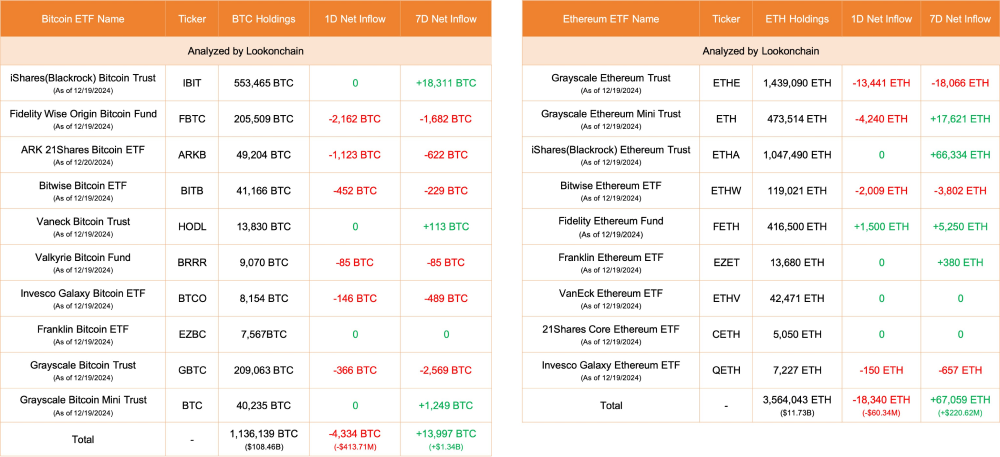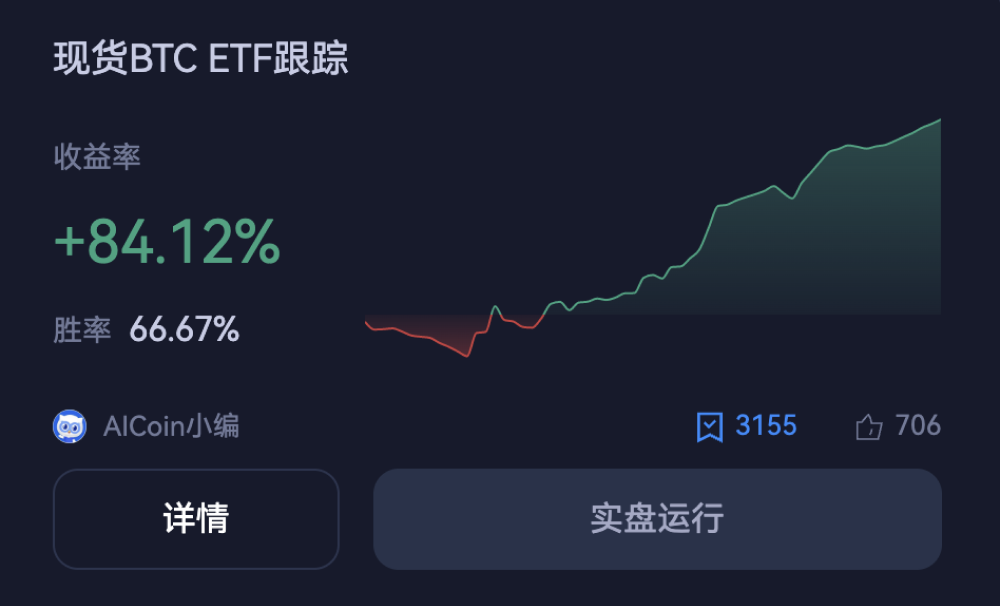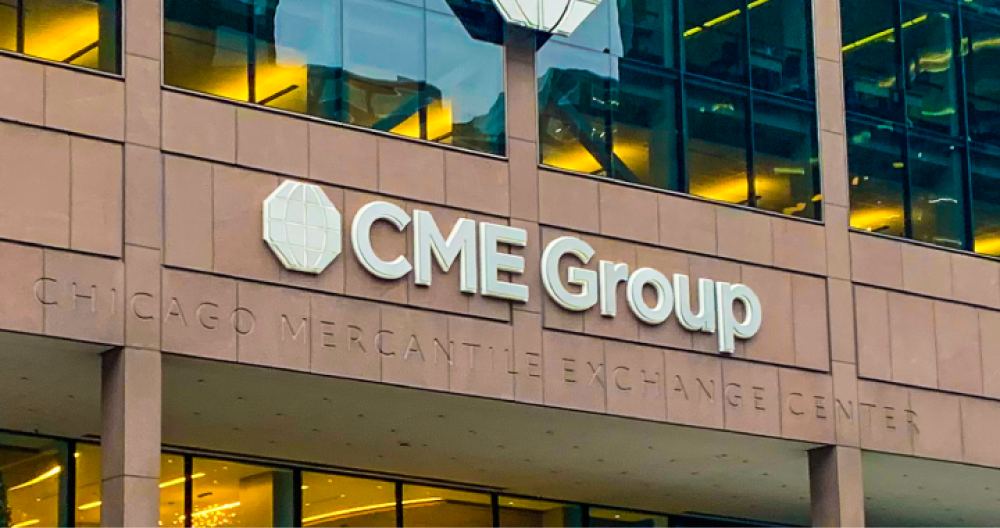Recently, the outflow of funds from spot Bitcoin ETFs has drawn collective attention from the market. Particularly in December 2024, a sudden wave of capital withdrawal has focused investors' attention on the short-term demand weakness in the Bitcoin market. The digital asset market is ever-changing, and the motivations and impacts behind this capital withdrawal are worth deep analysis.
Scale of Fund Outflow: The Origins and Consequences of a "Small Capital Earthquake"
According to data, on December 23, 2024, ten spot Bitcoin ETFs recorded a net outflow of 5,353 BTC, equivalent to about $502 million. The Grayscale Bitcoin Trust (GBTC) lost 1,959 BTC in a single day, while BlackRock's ETF IBIT attracted a net inflow of $31.6575 million, yet the overall market still showed a net outflow trend.

Even more strikingly, on December 24, funds continued to withdraw significantly, with outflows reaching approximately $220 million. In just two days, the "great escape" of capital halted the trend of fund inflows in the market. Behind these figures lies a significant change in market sentiment and investor psychology.
According to the AICoin developed Spot BTC ETF Tracking strategy, there is a significant positive correlation between ETF fund inflows and BTC prices, allowing for subscription indicators that enable automatic ordering based on fund flows.

Who is Retreating? Unlocking the Three Major Incentives Behind Fund Outflows
Emotional "Cold Wave": Price Volatility Impacts Market Confidence
The dramatic fluctuations in Bitcoin prices are undoubtedly one of the triggers for fund outflows. Entering December 2024, Bitcoin fell from its yearly high of $108,268 to $96,000, a decline of nearly 10%. This pullback quickly burst the market's "optimistic bubble," prompting investors to withdraw funds to avoid risks. In the short term, this price volatility has intensified market uncertainty, becoming a catalyst for fund outflows.
Federal Reserve "Aftershocks": Macroeconomic Clouds Loom
If price volatility is the surface phenomenon, then changes in the macroeconomic environment are the deeper driving factors. The Federal Reserve expressed concerns about economic growth and inflation prospects during its December policy meeting, leading to greater uncertainty about the future direction of monetary policy. The potential increase in interest rates not only puts pressure on traditional financial markets but also affects the attractiveness of risk assets like Bitcoin. The profit-seeking nature of capital has led investors to quickly adjust their portfolios amid uncertainty, making it difficult for spot Bitcoin ETFs to avoid being "under-allocated."
CME Futures Premium "Cooling": Decreased Arbitrage Appeal
The fluctuations in the CME Bitcoin futures market's premium have also alerted the market. Data shows that as of mid-December, the annualized premium of CME Bitcoin futures had dropped to 9.83%, reaching a new low in over a month. This means that the profit potential for arbitrage trading has been compressed, cooling institutional interest in spot Bitcoin ETFs. With fewer arbitrage opportunities, the flow of funds naturally changes.

Market "Epicenter": The Triple Shockwaves Triggered by Fund Outflows
When the tide of capital recedes, market liquidity becomes the primary victim. The withdrawal of funds from spot Bitcoin ETFs directly weakens the market's buying power, increasing selling pressure and creating downward pressure on Bitcoin prices. Although the market may appear weak in the short term due to fund outflows, in the long run, the inflow and outflow of funds is an inevitable process of market self-regulation. In other words, this volatility may be a "metabolic" phenomenon of healthy market development.
The large-scale outflow of funds has a significant impact on market sentiment, especially for new investors entering the market; this is undoubtedly a "crisis of faith." They may interpret the fund outflows as a signal that the market is about to collapse, triggering more panic selling. However, for seasoned long-term investors, this is merely another cycle of market adjustment. They tend to focus more on Bitcoin's long-term value rather than short-term fund movements.
The phenomenon of fund outflows may also attract the attention of regulatory agencies. As a relatively new investment product, the market performance and fund movements of spot Bitcoin ETFs are already under scrutiny. Large-scale capital withdrawals may prompt regulators to reassess the market rules for ETFs, potentially affecting the approval process for future new products. It can be said that capital choices not only impact the market but also influence the pace of policy to some extent.
The Road Ahead: Short-Term Volatility or Long-Term Opportunity?
Although spot Bitcoin ETFs have recently experienced a "cold winter" of fund outflows, in the long run, this product remains a crucial cornerstone for market development. The launch of ETFs not only facilitates institutional investors' entry into the Bitcoin market but also significantly enhances market transparency and credibility. These advantages will not disappear due to short-term volatility. In the future, as the market gradually matures, especially with deeper participation from more institutional capital, Bitcoin ETFs are expected to attract capital back. The short-term fund outflows may just be part of market adjustments rather than a reversal of long-term trends. For investors, the current market volatility is more like a test: whether to choose to panic and exit or to seek new investment opportunities amid the turmoil.
Conclusion
The phenomenon of fund outflows from spot Bitcoin ETFs undoubtedly serves as a wake-up call for the market. However, like every market fluctuation, challenges often hide opportunities. This wave of capital withdrawal reflects investors' short-term concerns about the market and prompts us to reassess the fundamentals and investment logic of the Bitcoin market.
For ordinary investors, market volatility should not be a reason for panic but rather an opportunity to optimize asset allocation. Rational investment and long-term holding remain the best ways to navigate the digital asset market. After all, after the storm, it is the long-term investors who truly take the stage.
If you have any questions, you can contact us through the following official channels:
AICoin Official Website: www.aicoin.com
Telegram: t.me/aicoincn
Twitter: x.com/AICoincom
Email: support@aicoin.com
Group Chat: Customer Service Yingying、Customer Service KK
免责声明:本文章仅代表作者个人观点,不代表本平台的立场和观点。本文章仅供信息分享,不构成对任何人的任何投资建议。用户与作者之间的任何争议,与本平台无关。如网页中刊载的文章或图片涉及侵权,请提供相关的权利证明和身份证明发送邮件到support@aicoin.com,本平台相关工作人员将会进行核查。




